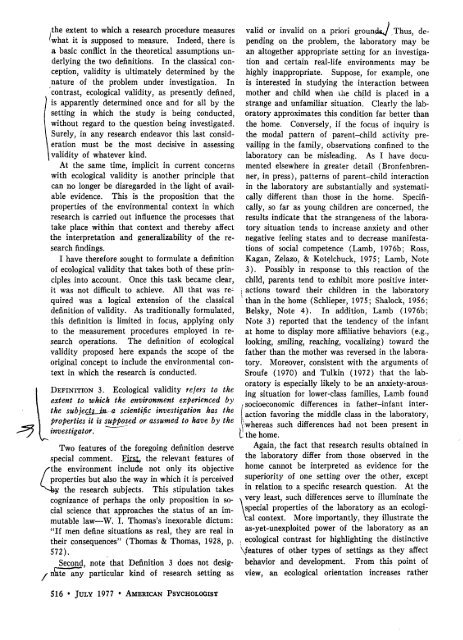Bronfenbrenner 1977
Create successful ePaper yourself
Turn your PDF publications into a flip-book with our unique Google optimized e-Paper software.
the extent to which a research procedure measures<br />
'what it is supposed to measure. Indeed, there is<br />
a basic conflict in the theoretical assumptions underlying<br />
the two definitions. In the classical conception,<br />
validity is ultimately determined by the<br />
nature of the problem under investigation. In<br />
contrast, ecological validity, as presently defined,<br />
is apparently determined once and for all by the<br />
setting in which the study is being conducted,<br />
without regard to the question being investigated.<br />
Surely, in any research endeavor this last consideration<br />
must be the most decisive in assessing<br />
validity of whatever kind.<br />
At the same time, implicit in current concerns<br />
with ecological validity is another principle that<br />
can no longer be disregarded in the light of available<br />
evidence. This is the proposition that the<br />
properties of the environmental context in which<br />
research is carried out influence the processes that<br />
take place within that context and thereby affect<br />
the interpretation and generalizability of the research<br />
findings.<br />
I have therefore sought to formulate a definition<br />
of ecological validity that takes both of these principles<br />
into account. Once this task became clear,<br />
it was not difficult to achieve. All that was required<br />
was a logical extension of the classical<br />
definition of validity. As traditionally formulated,<br />
this definition is limited in focus, applying only<br />
to the measurement procedures employed in research<br />
operations. The definition of ecological<br />
validity proposed here expands the scope of the<br />
original concept to include the environmental context<br />
in which the research is conducted.<br />
DEFINITION 3. Ecological validity refers to the<br />
extent to which the environment experienced by<br />
the subjectzJitt- a scientific investigation has the<br />
properties it is supposed or assumed to have by the<br />
investigator. ~~<br />
Two features of the foregoing definition deserve<br />
special comment. Fjxsi, the relevant features of<br />
/•the environment include not only its objective<br />
/ properties but also the way in which it is perceived<br />
^-by the research subjects. This stipulation takes<br />
cognizance of perhaps the only proposition in social<br />
science that approaches the status of an immutable<br />
law—W. I. Thomas's inexorable dictum:<br />
"If men define situations as real, they are real in<br />
their consequences" (Thomas & Thomas, 1928, p.<br />
572).<br />
Second, note that Definition 3 does not desig-<br />
/ nate any particular kind of research setting as<br />
516 • JULY <strong>1977</strong> • AMERICAN PSYCHOLOGIST<br />
valid or invalid on a priori ground*y Thus, depending<br />
on the problem, the laboratory may be<br />
an altogether appropriate setting for an investigation<br />
and certain real-life environments may be<br />
highly inappropriate. Suppose, for example, one<br />
is interested in studying the interaction between<br />
mother and child when the child is placed in a<br />
strange and unfamiliar situation. Clearly the laboratory<br />
approximates this condition far better than<br />
the home. Conversely, if the focus of inquiry is<br />
the modal pattern of parent-child activity prevailing<br />
in the family, observations confined to the<br />
laboratory can be misleading. As I have documented<br />
elsewhere in greater detail (<strong>Bronfenbrenner</strong>,<br />
in press), patterns of parent-child interaction<br />
in the laboratory are substantially and systematically<br />
different than those in the home. Specifically,<br />
so far as young children are concerned, the<br />
results indicate that the strangeness of the laboratory<br />
situation tends to increase anxiety and other<br />
negative feeling states and to decrease manifestations<br />
of social competence (Lamb, 1976b; Ross,<br />
Kagan, Zelazo, & Kotelchuck, 1975; Lamb, Note<br />
3). Possibly in response to this reaction of the<br />
child, parents tend to exhibit more positive interi<br />
actions toward their children in the laboratory<br />
' than in the home (Schlieper, 1975; Shalock, 1956;<br />
Belsky, Note 4). In addition, Lamb (1976b;<br />
Note 3) reported that the tendency of the infant<br />
at home to display more affiliative behaviors (e.g.,<br />
looking, smiling, reaching, vocalizing) toward the<br />
father than the mother was reversed in the laboratory.<br />
Moreover, consistent with the arguments of<br />
Sroufe (1970) and Tulkin (1972) that the laboratory<br />
is especially likely to be an anxiety-arousing<br />
situation for lower-class families, Lamb found<br />
socioeconomic differences in father-infant interaction<br />
favoring the middle class in the laboratory,<br />
'whereas such differences had not been present in<br />
I the home.<br />
Again, the fact that research results obtained in<br />
the laboratory differ from those observed in the<br />
home cannot be interpreted as evidence for the<br />
superiority of one setting over the other, except<br />
in relation to a specific research question. At the<br />
yvery least, such differences serve to illuminate the<br />
\special properties of the laboratory as an ecological<br />
context. More importantly, they illustrate the<br />
as-yet-unexploited power of the laboratory as an<br />
, ecological contrast for highlighting the distinctive<br />
\features of other types of settings as they affect<br />
behavior and development. From this point of<br />
view, an ecological orientation increases rather


